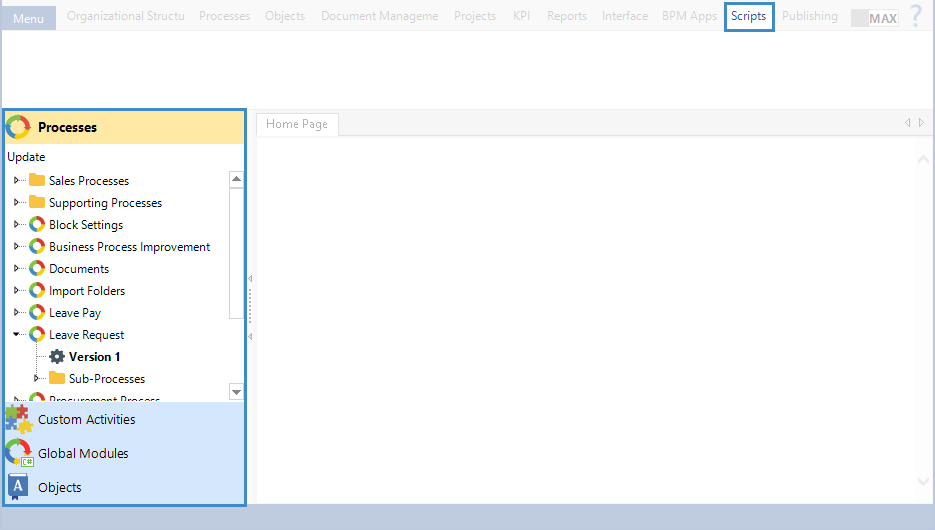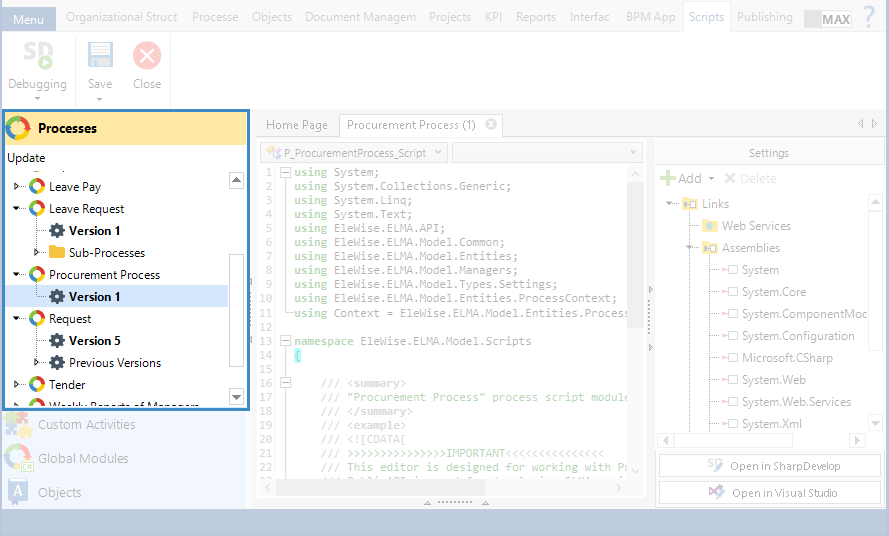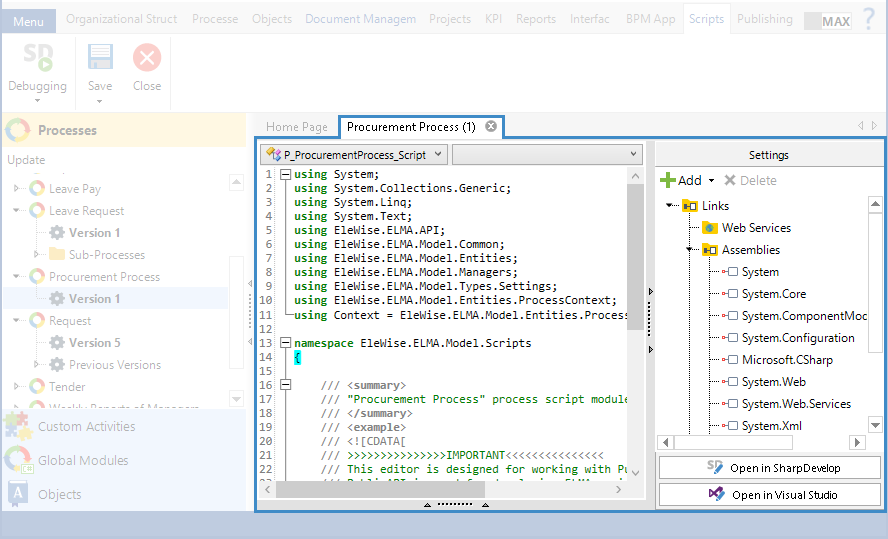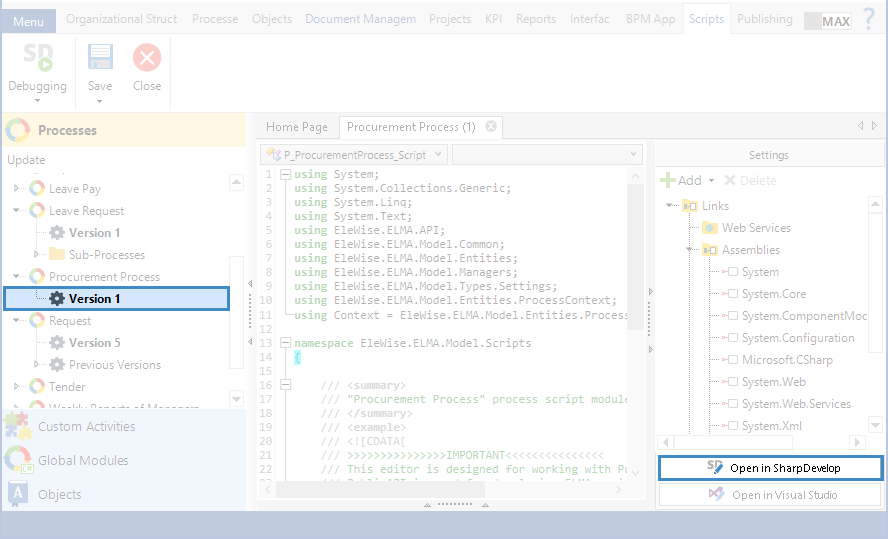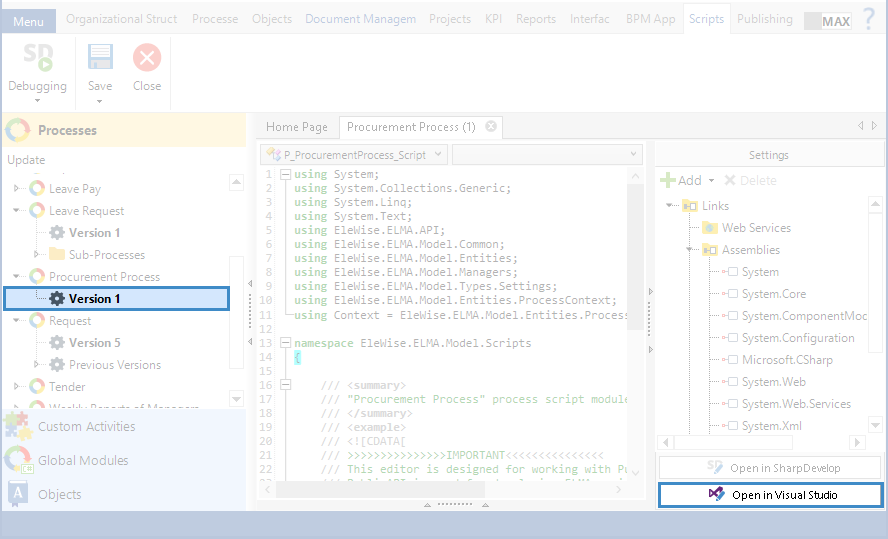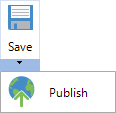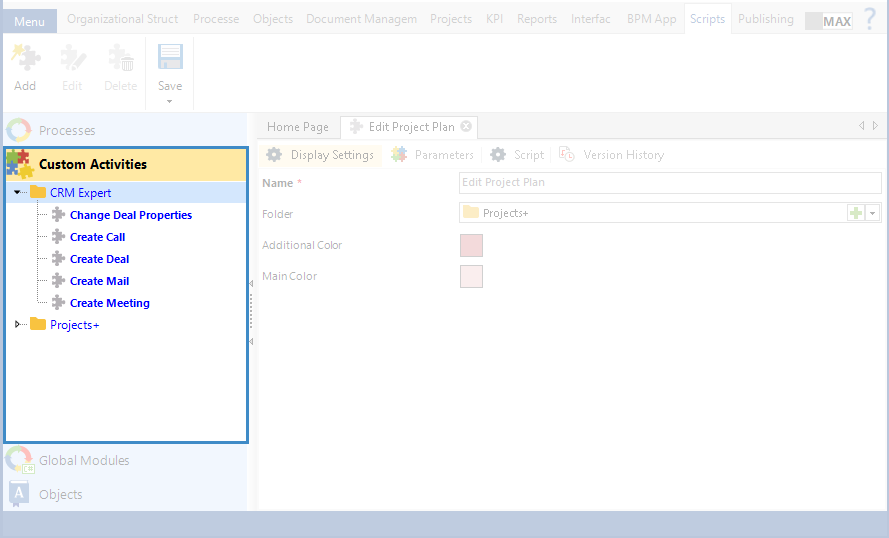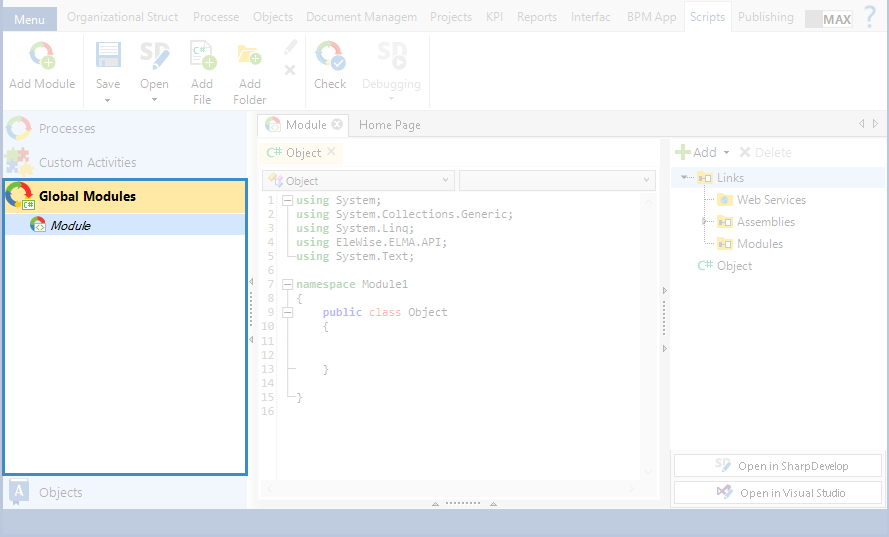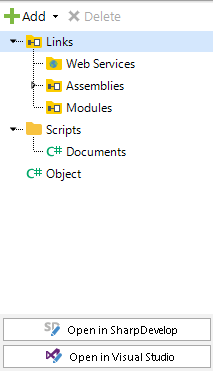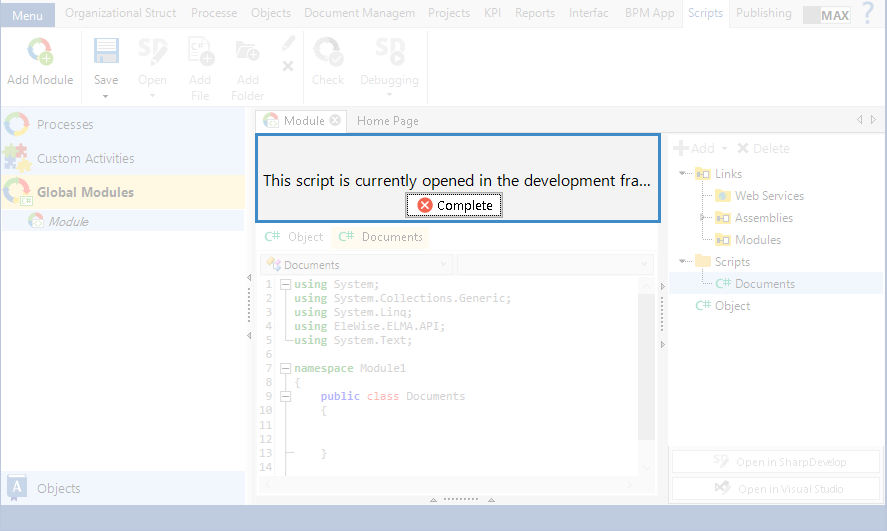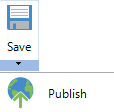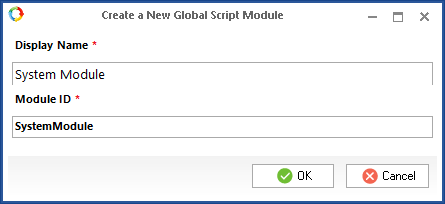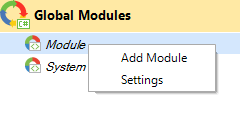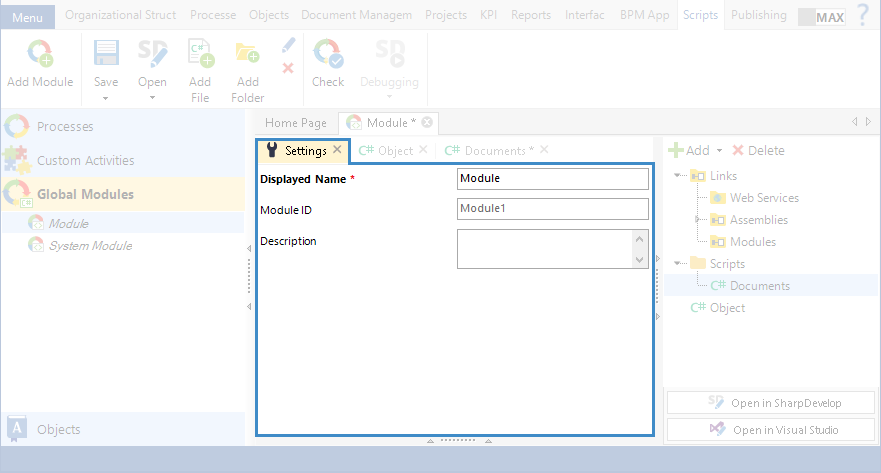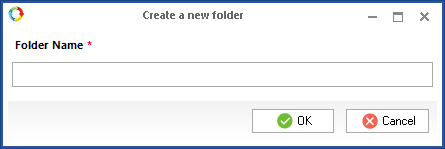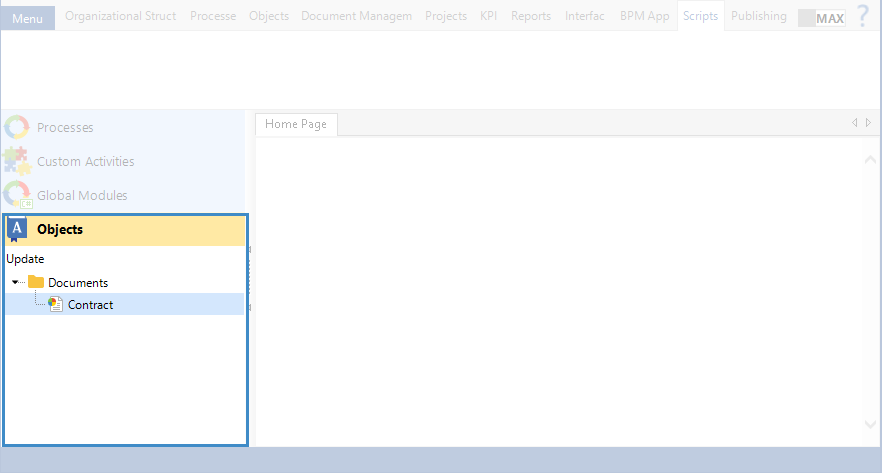Scripts Tab of ELMA Designer
The Scripts tab of ELMA Designer allows you to:
By default, this tab features the Home Page and the side panel (fig. 1) for accessing one of the four subsections:
To view the content of a subsection, click on the name of the required subsection on the side panel (fig. 1).
Fig. 1. ELMA Designer. Scripts tab
Processes
This subsection contains the list of published and outdated process versions (fig. 2). Note, that unlike the Scripts tab of a process page, this tab does not show the scripts of process drafts.
Fig. 2. ELMA Designer. Scripts tab. Side panel. Processes subsection
When you click on the  icon next to a process name, the last published version is displayed (in bold) as well as the Previous Versions group. When you click on the
icon next to a process name, the last published version is displayed (in bold) as well as the Previous Versions group. When you click on the  icon, next to the Previous Versions group, all the outdated process versions are shown. Click Update at the top of the list to update the list of processes and versions.
icon, next to the Previous Versions group, all the outdated process versions are shown. Click Update at the top of the list to update the list of processes and versions.
All the scripts of one process are in one module. Each scripts module pertains to a certain process version.
You can work with a scripts module in one of five modes:
1. Quick editing. In this mode, you can edit the scripts of a published or outdated process version. After publishing the scripts module, the instances of the edited process version, running in Web Application, will work with the edited module.
When a module is in the editing mode, the tab name contains the process name and the number of the edited process version (in parentheses). The functions, available in the script view block, are similar to those on the Scripts tab of a process page (if you are using the script editor). To open the scripts module in this mode, double-click on the version number of the required process.
Fig. 3. ELMA Designer. Scripts tab. Quick script editing mode
2. Editing in SharpDevelop. To open a scripts module in SharpDevelop, select the required process version and click Open in SharpDevelop (fig. 4).
Fig. 4. ELMA Designer. Scripts tab. Open in SharpDevelop button
3. Editing in Microsoft Visual Studio. This feature is available only if you have the Microsoft Visual Studio Community/Enterprise 2010-2015 installed. To open a scripts module in MS Visual Studio, select a process version and click Open in Visual Studio (fig. 5).
Fig. 5. ELMA Designer. Scripts tab. Open in Visual Studio button
4. Debugging in SharpDevelop. In this mode, you cannot edit the script. To open a scripts module in this mode, select a process version and click Debugging in the toolbar.
5. Debugging in Microsoft Visual Studio. This feature is available only if you have the Microsoft Visual Studio Community/Enterprise 2010-2015 installed. To open a scripts module in this mode, select a process version and click Debugging - Debugging in Visual Studio in the toolbar.
Toolbar buttons
|
|
-
Debugging Visual Studio – open the script for debugging in Microsoft Visual Studio. This button is available only if Microsoft Visual Studio Community/Enterprise 2010-2015 is installed.
|
|
|
Save and publish the scripts module of the process version, currently open on the active tab.
|
|
|
Close the active tab with a process scripts module.
|
Custom activities
A custom activity is a custom script, saved to the ELMA Designer activities, which has input/output parameters, display settings and program code that define the actions performed by the custom activity in a process. This subsection (fig. 6) displays all the custom activities, and allows you to create new ones and edit/delete existing ones.
Fig. 6. ELMA Designer. Scripts tab. Custom Activities subsection
Global modules
Global modules are global procedures and/or functions that can be used in processes, objects, interfaces and other modules for implementing system extensions.
This subsection (fig. 7) displays the list of all the system global modules and allows you to create new ones and view and/or edit existing ones.
Fig. 7. ELMA Designer. Scripts tab. Global modules subsection
The unpublished modules have names in italics and the edited and unpublished modules have names in bold.
Each global module may consist of several files, each file is a C# script. You can open several files at the same time on different tabs.
To the right of the work pane, there is a panel (fig. 8), with links to web services, global assemblies and modules, and files - C# scripts used in the global module.
Fig. 8. ELMA Designer. Scripts tab. Global modules subsection. Right panel
The panel features two buttons:
|
|
|
|
|
Delete the selected file/folder.
|
Fig. 9. Notification that the script is opened in a development environment
Toolbar buttons of the Global Modules subsection
|
|
|
|
|
Save – save the changes made to the global module, currently open in the active tab.
-
Publish – the global module, open in the active tab.
|
|
|
-
Open in Visual Studio – open the current script in Visual Studio. This button is available only if you have Microsoft Visual Studio Community/Enterprise 2010-2015 installed.
|
|
|
Create a file of a public class, containing a C# script in the global module.
|
|
|
|
|
|
Open the selected public class file for viewing or editing.
|
|
|
Delete the selected public class or folder from the global module.
|
|
|
|
|
|
-
Debugging in Visual Studio – open the script for debugging in Visual Studio. This button is available only if you have Microsoft Visual Studio Community/Enterprise 2010-2015 installed.
|
To create a global module, click Add Module in the toolbar or select Add Module in the context menu. A dialog box for creating a new global module will open (fig. 10) where you need to fill in the fields and click OK. Note, that you cannot change the Module ID field after creating a module.
Fig. 10. Creating a module
The new module will be created and displayed in the Global Modules subsection.
Global module context menu
To open the context menu of a global module, right click on the name of the required module. The context menu includes two buttons (fig. 11):
Fig. 11. Global module context menu
-
Add Module – create a new global module;
-
Settings – when you click on this button a tab with the global module parameters opens (fig. 12). This tab is similar to the global module creation form. The difference is that the settings tab contains the Description field, in which you can add a module description.
Fig. 12. Settings tab of a global module
Global module folders
Folders allow grouping global module public class files.
Actions with folders
There are several ways to create a folder:
-
-
-
select Add Folder in the context menu of an existing folder.
The folder creation window will open (fig. 13), where you need to enter the folder name and click OK.
Fig. 13. Folder creation window
The folder will be added to the right panel.
To change a folder name, select Rename in the folder's context menu. In the opened window, make the required changes and click OK.
To delete a folder, select Delete in the folder's context menu or click  in the toolbar. In the opened window, confirm deleting the folder by clicking Yes. Note, that all the nested folders and files will be deleted as well.
in the toolbar. In the opened window, confirm deleting the folder by clicking Yes. Note, that all the nested folders and files will be deleted as well.
Global module files
File – a public class file with a C# script. A global module may consist of several files.
Actions with a file
There are several ways to create a file:
-
-
-
select Add File in the context menu of an existing folder.
The file creation window will open (fig. 14), where you need to enter the file name and click OK.
Fig. 14. File creation window
The file will be created and opened for editing on the work pane. If you select one of the folders when creating a file or created the file in a folder's context menu, it will be added to this folder.
There are several ways to open a file for editing:
-
double-click on the file name;
-
select Edit in the file context menu;
-
click  in the toolbar.
in the toolbar.
The file will be opened on the work pane of the global module. You can open several files at the same time. Files are opened on different tabs in one module.
To rename a file, select Rename in the context menu.
To delete a file, select Delete in the context menu or click  in the toolbar.
in the toolbar.
Objects
This subsection (fig. 15) displays the list of all the objects containing scripts. When you double-click on an object, its page opens on the Scripts tab. The Update button at the top of the list allows updating the list of objects.
Fig. 15. ELMA Designer. Scripts tab. Objects subsection
Search on the Scripts tab
Copyright © 2006–2019 ELMA
